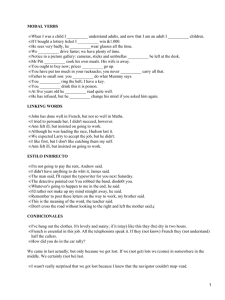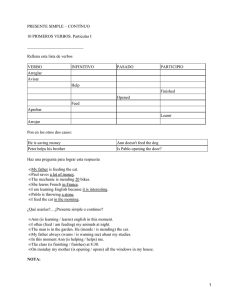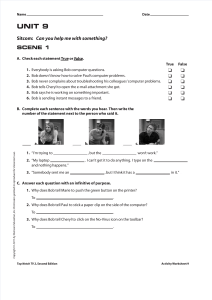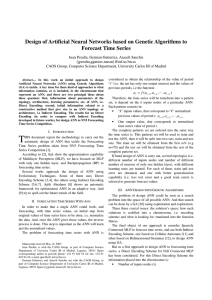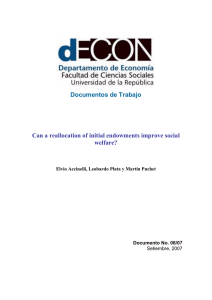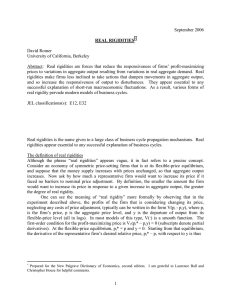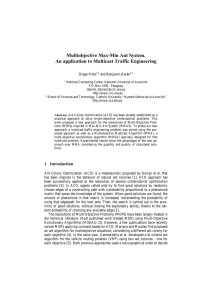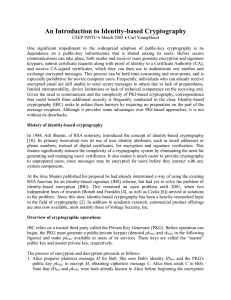Economics 501B Final Exam
Anuncio
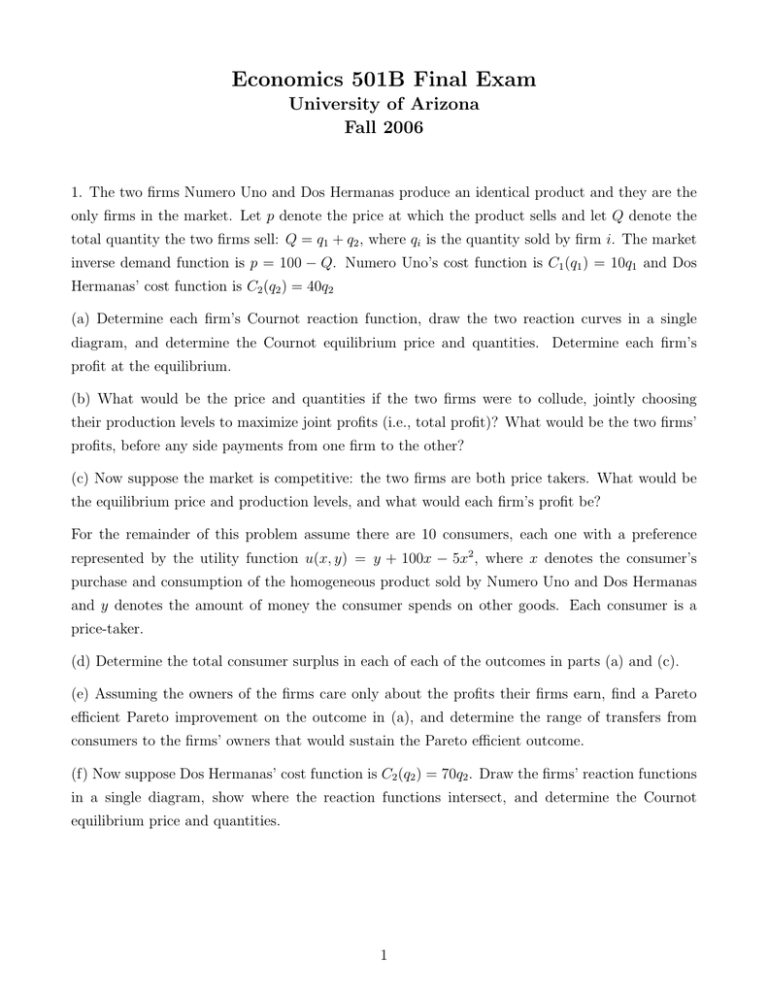
Economics 501B Final Exam University of Arizona Fall 2006 1. The two firms Numero Uno and Dos Hermanas produce an identical product and they are the only firms in the market. Let p denote the price at which the product sells and let Q denote the total quantity the two firms sell: Q = q1 + q2 , where qi is the quantity sold by firm i. The market inverse demand function is p = 100 − Q. Numero Uno’s cost function is C1 (q1 ) = 10q1 and Dos Hermanas’ cost function is C2 (q2 ) = 40q2 (a) Determine each firm’s Cournot reaction function, draw the two reaction curves in a single diagram, and determine the Cournot equilibrium price and quantities. Determine each firm’s profit at the equilibrium. (b) What would be the price and quantities if the two firms were to collude, jointly choosing their production levels to maximize joint profits (i.e., total profit)? What would be the two firms’ profits, before any side payments from one firm to the other? (c) Now suppose the market is competitive: the two firms are both price takers. What would be the equilibrium price and production levels, and what would each firm’s profit be? For the remainder of this problem assume there are 10 consumers, each one with a preference represented by the utility function u(x, y) = y + 100x − 5x2 , where x denotes the consumer’s purchase and consumption of the homogeneous product sold by Numero Uno and Dos Hermanas and y denotes the amount of money the consumer spends on other goods. Each consumer is a price-taker. (d) Determine the total consumer surplus in each of each of the outcomes in parts (a) and (c). (e) Assuming the owners of the firms care only about the profits their firms earn, find a Pareto efficient Pareto improvement on the outcome in (a), and determine the range of transfers from consumers to the firms’ owners that would sustain the Pareto efficient outcome. (f) Now suppose Dos Hermanas’ cost function is C2 (q2 ) = 70q2 . Draw the firms’ reaction functions in a single diagram, show where the reaction functions intersect, and determine the Cournot equilibrium price and quantities. 1 2. Ann and Bob share a house. Ann likes to keep the house warmer than Bob does. Ann’s preference is described by the utility function uA (x, yA ) and Bob’s preference is described by the utility function uB (x, yB ), where x denotes the temperature in the house in degrees Fahrenheit and yA and yB denote the amount of money each person has available each week to spend on other goods. Changing the temperature is costless. (a) When there are no externalities, the marginal condition that characterizes the Pareto allocations is M RSA = M RSB if there are two persons and two goods. What is the corresponding marginal condition that characterizes the Pareto allocations in Ann’s and Bob’s situation? (b) Write down a maximization problem that characterizes the Pareto allocations – i.e., a problem for which the solutions are the Pareto efficient allocations – and use this problem to derive the marginal condition in (a). (c) Assume that Ann’s and Bob’s utility functions are uA (x, yA ) = yA − (x − 75)2 and uB (x, yB ) = yB − 12 (x − 69)2 . Use the marginal condition in (a) to determine the set of interior Pareto allocations. (d) Suppose Ann and Bob agree that since Ann owns the house, she has the right to set the temperature at whatever level she wishes. But they realize they could both be better off if Ann sets the temperature below 75 degrees and Bob compensates her for being a little colder than she would like. They turn to you, their economist friend, to recommend a solution – a temperature and weekly compensation amount that will make them both better off than when Ann simply sets the temperature at 75 degrees, and which they can’t jointly improve upon. What temperature do you recommend? What are the largest and smallest weekly transfers from Bob to Ann that will make neither one worse off than with no agreement? (e) Now suppose that changing the temperature is not costless. If the air conditioning unit is not turned on, the temperature in the house will be 85 degrees. By using the air conditioner the temperature can be reduced: every degree the temperature is reduced below 85◦ requires electricity that costs six dollars per week – i.e., the weekly cost of keeping the temperature at x degrees is C(x) = 6(85 − x) if x 5 85. Determine the temperature that’s consistent with Pareto efficiency. 2 3. Half the people in the economy are Type A personalities and the other half are Type B. Type A personalities all choose according to the utility function uA (x0 , xH , xL ) = x0 + 5xH − .3x2H + 3xL − .3x2L and Type B personalities all choose according to the utility function uB (x0 , xH , xL ) = x0 + 5xH − .4x2H + 3xL − .2x2L , where x0 represents consumption “today,” xH represents consumption “tomorrow” in state H, and xL represents consumption “tomorrow” in state L. Each person is endowed with six units of the good today. Type A people will be endowed with four units tomorrow in state H and only two units in state L; Type B people will be endowed with ten units tomorrow in state H and eight units in state L. Storage of the consumption good from today until tomorrow is not possible. The two states are mutually exclusive and exhaustive. In your answers, consider only allocations that give all Type A people the same state-contingent consumption bundle and all Type B people the same state-contingent consumption bundle. You can therefore describe an allocation with just the six variables xA0 , xAH , xAL , xB0 , xBH , xBL . (a) Determine the set of interior Pareto allocations. (b) Determine the Arrow-Debreu prices and allocation. (c) [WARNING: This part will take longer than the others. You may want to skip it and return to it later if you have time.] Assume that the only market is a credit market – a market for borrowing and lending. There are no markets in which one can insure oneself against either of tomorrow’s two possible states. What will be the competitive interest rate, and how much will each person borrow or save? (d) In addition to the credit market in (c), suppose there is another market as well, in which one can buy or sell insurance today against the occurrence of state H. Each unit of insurance that a person purchases is a contract in which the seller of the contract agrees to pay the buyer one unit of consumption tomorrow if state H occurs. Let p denote the market price of the insurance: the buyer pays the seller p units of consumption today for each unit of insurance he purchases. Determine the competitive equilibrium prices (i.e., the interest rate and the price p of insurance) and the equilibrium allocation. How much does each person borrow or save, and how much insurance does each person buy or sell? (e) Are the allocations in (c) and (d) Pareto efficient? Explain. 3
